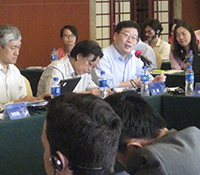
Chinese policymakers, senior academics, and more than 100 researchers, scientists and industry leaders gathered last week for the Second Annual Stakeholders Meeting of the Tsinghua-MIT China Energy and Climate Project (CECP). At the yearly gathering, participants reflected on the state of climate policy in China and the progress of the multi-disciplinary partnership, which launched last year to develop new tools to solve China’s most challenging climate and energy policy questions.
“In light of the recent agreement between Presidents Obama and Xi to limit hydrofluorocarbons—a potent greenhouse gas—we hope that close work between the two countries continues,” said Henry Jacoby, co-director emeritus of the MIT Joint Program on the Science and Policy of Global Change, during his keynote address. “In this context, the work of the CECP becomes ever more important.”
Jointly hosted by CECP’s parent research groups—the Tsinghua University Institute for Energy, Environment, and Economy and the MIT Joint Program on the Science and Policy of Global Change—the meeting creates a platform for a diverse group of policymakers to interact with researchers and explore future paths for China’s energy and climate policy. The number of external attendees more than quadrupled from last year’s conference, indicating the high level of interest in the Tsinghua-MIT collaboration and China's energy and climate policy more broadly. Senior officials from China's National Development and Reform Commission, National Energy Administration, Ministry of Industry and Information Technology, and Ministry of Science and Technology, as well as leading Chinese academics, formed a panel of experts that responded to the findings of the joint research team. Over 150 stakeholders representing industries, governments, and academic institutions in China and abroad attended the meeting, reflecting CECP's goal of sharing project insights with a broad range of global leaders on energy and climate topics.
The meeting’s main dialogue between CECP researchers and policymakers focused on future drivers of energy use and the design of a carbon emissions trading schemes (ETS) in China, a subset of the CECP’s ongoing work. CECP researchers compared China’s current climate policy—provincial carbon intensity targets—to national emissions trading system designs that varied in terms of sector and regional coverage. CECP researchers underscored the need for broad sector and geographic coverage to enhance ETS cost effectiveness, as well as the potential to achieve equity goals through the initial allocation of emissions permits.
In the afternoon, a panel of policy advisors representing planned pilot emissions trading systems in Beijing, Guangdong, Shanghai, Tianjin, and Hubei described the design and progress toward implementation, which is expected to be complete by the end of 2013. Panel participants emphasized that pilot schemes build familiarity with emissions trading and help policymakers evaluate the feasibility of a national ETS.
The CECP’s leaders, Dr. Valerie Karplus of MIT and Professor ZHANG Xiliang of Tsinghua, explained these findings based on two models they developed over the last year: the China-Global Energy Model (C-GEM) and the China-Regional Energy Model (C-REM). While the C-REM model allowed the researchers to uncover their ETS findings, the C-GEM model provided analysis on China’s "economic transformation"— the effort to move from an energy and emissions intensive economy focused on manufacturing for export to one that is more services and technology oriented.
Prof. ZHANG highlighted the importance of the MIT-Tsinghua relationship in bringing about these results. “The regular exchange of Tsinghua students working at MIT, and MIT students and researchers visiting Tsinghua, makes for a very productive working relationship,” Prof. ZHANG said, acknowledging the support of sponsors on both the MIT and Tsinghua sides. MIT founding sponsors include French Development Agency, Eni, ICF International (a consultancy), and Shell, while the collaboration receives support at Tsinghua from the Ministry of Science and Technology, National Development and Reform Commission, and the National Energy Administration.
Alongside government representatives, a number of senior academics from China's top universities in a variety of disciplines offered their input on the CECP's ongoing research efforts. The experts identified key ramifications from the results and called attention to future topics of interest.
“An important goal of this meeting is to bring the key stakeholders together in the same room,” said Karplus, “This helps to foster a shared awareness of the wide range of views on policy options that reflect the diverse circumstances facing China’s localities and industries.”

